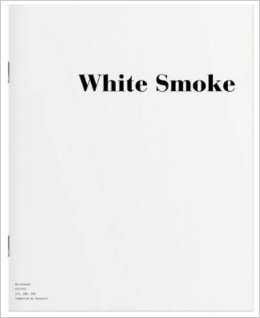Detalles
Editores
Onomatopee, Eindhoven
Encuadernación
Tapa blanda
Descripción
previous / next Exhibition Onomatopee 51 / Cabinet project White Smoke A project by Hexaplex In the White Smoke project by Hexaplex man and machine engage: the audience engages a world of color codes and names. On the eve of the information era, White Smoke lays down poetic and semantic tensions between man and machine! White Smoke encourages the audience to enter the information society with human, poetical effort! As blue as the air, as green as a leaf: we take colors for granted. Until now color and object overlapped: ink is a usable material with a color that can be applied directly. Objects have the color that they have. For example, we recognise hard, primary colors from the works of Dick Bruna and the works of Nieuwe Zakelijkheid. We know ink as basic instrument of many paintings. From Gerhard Richter to Karel Appel and beyond: ink carries the image. But is color still just green, red and blue? The images we see nowadays are more and more often conceived through digital windows. The presented colors are data waves. What is green, red, blue or white in this reality? And: how do we interpret these; what exactly is white? Like the Inuit distinguishing sorts of white, like being able to buy sorts of white at a do it yourself store, from broken white to cream and further, the digital world also distinguishes an infinite range of whites. Right before the definitive arrival of the information society, man and machine attribute names to this range of colors. Steadily, a spectrum of names is created: on one hand in codes, on the other hand subjectively determined. For example the machine determined that there is a light color of grey which is coded as “#F5F5F”or in the identity of a RBG value as “245, 245, 245”. A web browser then gave the name ‘White Smoke’ to this code: a very trivial name. White Smoke sounds very nice, but comes from a cold heart. This heart creates its own codes as well as it labels them in itself. Who determines these differentiating labels? Man or machine? How objective is this difference? The machine takes over our subjective interpretation. Even color, being an outstanding means of expression, is at stake. Before we know it, the machine creates our art, directs and determines our experiences, like plasma TV screens boost the color of our window on the world to the extend we don’t even want to see the real world anymore! The publication contains a text by Audrey Samson (new-media theorist) explaining the evolution of color experiences from the perspective of new media. Freek Lomme (Onomatopee) describes the cultural poetry of White Smoke. To finish the sum, there’s also a conversation between Hexaplex and Steven Pemberton (W3C) about the history of web clors + much White Smoke! — Testi: Lomme Freek, Pemberton Steven et al. pagg. 24; BN; rileg. brossura. Editore: Onomatopee, Eindhoven, 2010.

Descubre cómo utilizar
Descubre cómo utilizar

